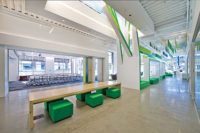
The University of Pennsylvania’s advocacy of sustainable design extends from LEED ratings targets for all new building projects to collaborative efforts between the Division of Facilities and Real Estate Services, the campus community and the City of Philadelphia. Campus-wide environmental planning for the built environment has included the reuse of materials and installation of green roofs. The strategic examination of university buildings and implementation of improvements for long-term energy and operational efficiency have also been performed.
Three window replacement projects reflect energy savings measures and green building principles that the University of Pennsylvania has been actively pursuing. As part of the Kings Court-English College House complex, English House was built in 1960 as a nursing student dormitory. Its mid-century “International Style” design was by architects Schmidt, Garden, and Erikson. The 1941 Cret Chemistry Building is the oldest surviving wing of the original chemistry complex. The Sigma Chi Fraternity House, built in 1884 as a residence for James W. Paul, Jr. and Frances Katherine Drexel, exemplifies late 19th century residential architecture. The three projects represent different architectural eras, window details and challenges; however, all three share an architectural approach to window replacement in an historic campus context.

The Ins and Outs
Runyan & Associates Architects of Philadelphia led design for all three. “We looked at each project from the inside-out, as well as the outside-in,” says principal, C. Stanley Runyan, AIA. The Runyan team included Jean McCoubrey, AIA, LEED AP and Matthew Yoder, who managed the projects internally along with the university’s project managers and under the guidance of its Design Review Committee.The best example of Runyan’s approach was in the renovation of English House, where half-century old aluminum windows with single-pane glass contributed to excessive heat loss in winter and heat gain in summer. The slider system was hard to operate and large, clear openings presented both a security threat and fall hazard. To complicate the replacement, original fin-tube radiators were attached to the window wall system. In order to replace the windows, the heating system also required an update, which presented an opportunity to offer individual thermostats in each room and improved energy efficiency. Exterior concrete restoration was a related project component.
Runyan called in Bruce E. Brooks & Associates for MEP engineering on English House, who consulted on both the new heating system and window glazing selection. Mechanical engineer Joe Matje, PE, LEED AP, developed a computer model using Carrier’s Hourly Analysis Program to analyze three different types of glazing, rating them good, better, and best based on life-cycle and first-time costs. PPG’s Solarban 60, a low-E solar control glass with 22 kBTU/square-foot per year, was chosen for combined performance and price benefit.
“We did a mock-up of the glass and the new fin tube,” Matje says. It was useful both to see how the new systems would look in the dorm rooms and to elicit comments from the university and the design team. In addition to the new fin-tube system, individual energy metering was installed on the campus steam loop.
Upon selection of the glazing and awning-style, top-hinged aluminum Wausau Windows (3250-H Heritage Series), the Runyan team proposed a slightly modified mullion spacing. The original mullion pattern could not be replicated, but the university wanted the new configuration to maintain the horizontality of the original scheme and the translucency of the lower fixed window panels. Twelve iterations of mullion configurations were presented and reviewed.
McCoubrey explained that functionality and interior sightlines were studied carefully. The final design maintains the three-part bay configuration of the original, but adds vertical mullions for a more complex visual aesthetic. Since the building does not include central air-conditioning, the university extended its typical window-opening limit from 4 to 8 inches to ensure adequate ventilation in compliance with building code requirements.
Superintendent and construction project manager for INTECH Construction Paul DeFeo managed the English House project. He cited accurate field measurements and proper cleaning and preparation prior to window installation as keys to success. The team surveyed dorm rooms during spring break before the summer construction schedule. The window system, which sits directly on the concrete floor slab and extends to the slab above, arrived in sections that slid into a track.
“I was impressed how the system went together,” says DeFeo, adding that the installers, GMI, performed well.

Cracks Corrected
Exterior envelope repairs to spalling and cracking concrete were corrected with input from exterior consultant, Edwards & Company, and using Conproco repair mortars and coatings from Capricorn Industrial Sales. “The goal of concrete restoration was to maintain color and texture of the natural concrete while protecting it from further deterioration,” says McCoubrey.Window replacement at English House was completed in the summer of 2009. The new, energy-efficient window and heating systems reduce solar gain, increase thermal comfort, and provide a refreshed look to the building. When combined with a green roof added a few years earlier, the dormitory demonstrates how environmentally-friendly design can be economic as well.
Runyan took a similar approach to the Paul P. Cret Wing of the Chemistry Building, where new energy-efficient aluminum windows were specified to replace original steel casements. Completed in 2005, the project addressed both energy consumption and interior environmental control issues through window replacement. “Within the laboratories, it is even more important to have weather-tight windows to provide for controlled environmental conditions,” says Stan Runyan. EFCO Corp. Model 590 aluminum windows with a fluoropolymer finish were specified because their profiles closely match steel sash profiles. Unkefer Brothers Builders of Philadelphia was the project’s contractor.
In 2010, the Penn chapter of the Sigma Chi Fraternity approved a complete window restoration and replacement project for its 1884 chapter house. Runyan & Associates Architects designed a multi-phased restoration for the entire exterior envelope. Sigma Chi’s former Drexel-Paul Mansion is listed on Philadelphia’s Register of Historic Places and required submissions and reviews with the University of Pennsylvania’s Design Review Committee, its Cultural Resources Subcommittee and the City of Philadelphia’s Historic Preservation Commission staff.

An accelerated summer construction schedule for restoring or replacing 70-plus windows was complicated by the fact that nearly every window has a different shape and size. In addition, ornate leaded-glass windows were restored and amended with custom storm sashes. The project exemplifies a successful use of contemporary standards for energy and functionality while maintaining respectful deference to the house’s historic exterior and interior common areas. The university will monitor energy savings as a result of the updates to inform future reinvestment.
“These three projects support the goals and objectives outlined in our Climate Action Plan, which strives to reduce the university’s carbon footprint and enhance its overall sustainability,” says Penn’s University Architect David Hollenberg, AIA. “The Runyan team was diligent in honoring the design of our buildings while bringing them up to date operationally.” Regardless of building age-whether 19th century, early 20th century or mid-century-window replacements and associated improvements can impact both energy efficiency and building longevity.



Report Abusive Comment